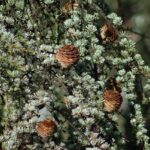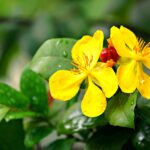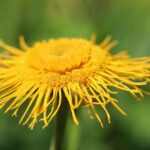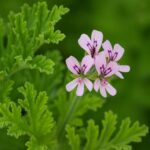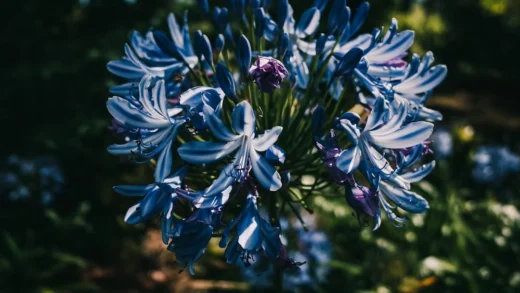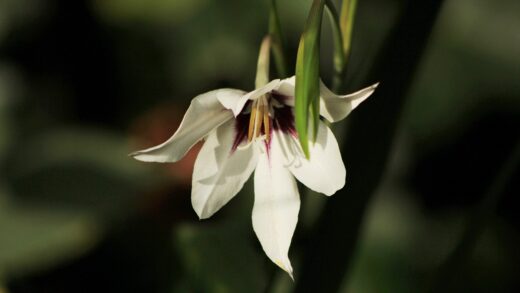The wild service tree is a robust and generally healthy species, well-adapted to its native environment and less prone to problems than many highly cultivated fruit trees. However, like any living organism, it is not entirely immune to diseases and pests. A knowledgeable gardener who can recognize the early signs of trouble is well-equipped to manage potential issues before they become severe. Proactive care, focusing on creating a healthy growing environment, is the best defense. This article will cover the most common fungal and bacterial diseases, insect pests, and abiotic disorders that can affect the wild service tree, and will conclude with an overview of integrated pest management strategies to maintain a healthy, thriving tree with minimal chemical intervention.
Common fungal diseases
Fungal diseases are among the more common issues that can affect the wild service tree, often thriving in damp, humid conditions with poor air circulation. One potential problem is powdery mildew, which appears as a white, dusty coating on the surface of leaves, shoots, and sometimes flowers. While it can be unsightly and may cause some leaf distortion, it is rarely a serious threat to the health of a mature tree. Good cultural practices, such as ensuring adequate spacing between trees to promote air movement and avoiding overhead watering, can significantly reduce its incidence. In persistent cases, sulfur-based fungicides or horticultural oils can be effective.
Another fungal issue to be aware of is canker, which can be caused by various fungi, such as Nectria. Cankers appear as sunken, discolored areas of dead bark on branches or the main trunk. These spots can girdle the branch, cutting off the flow of water and nutrients and eventually killing the limb. Cankers often gain entry to the tree through wounds, such as those from improper pruning or mechanical damage. The best management strategy is prevention: prune correctly during the dormant season and avoid wounding the tree. If a canker is found, the infected branch should be pruned out well below the cankered area and the material destroyed.
Leaf spot diseases can also occur, caused by a variety of different fungi. These typically manifest as dark, circular or irregular spots on the leaves, which may sometimes develop a yellow halo. In severe infections, the leaves may turn yellow and drop prematurely. While a heavy infestation can weaken the tree by reducing its photosynthetic capacity, it is not usually life-threatening. The most important control measure is good sanitation. Raking up and destroying fallen leaves in the autumn can break the disease cycle by removing the fungal spores that would otherwise overwinter and reinfect the tree the following spring.
Rust is another fungal disease, identifiable by the presence of small, orange or reddish-brown pustules on the undersides of the leaves. Like other fungal issues, it is most prevalent in wet seasons. Rust fungi often have complex life cycles that involve an alternate host plant. While it can reduce the tree’s vigor, rust is typically a cosmetic issue on wild service trees. Maintaining a healthy, well-fed, and properly watered tree is the best defense, as vigorous trees are better able to withstand and recover from such infections. Fungicidal treatments are rarely warranted for rust on a landscape tree.
More articles on this topic
Bacterial infections including fire blight
Bacterial diseases can be particularly destructive, and the most significant one for the wild service tree, as with other members of the rose family, is fire blight. Caused by the bacterium Erwinia amylovora, this disease can be devastating, especially to young trees. The symptoms are distinctive: blossoms and young shoots suddenly wilt and turn black, appearing as though they have been scorched by fire. The affected shoots often bend over into a characteristic ‘shepherd’s crook’ shape. The bacteria can spread rapidly through the tree’s vascular system, especially in warm, wet weather during the flowering period.
There is no chemical cure for fire blight, so management relies entirely on cultural practices and swift action. The primary method of control is sanitation. As soon as symptoms are noticed, the infected branches must be pruned out. It is critical to make the cut at least 30 centimeters (12 inches) into healthy wood, well below any visible sign of the infection. Between each cut, pruning tools must be sterilized with a disinfectant, such as a 10% bleach solution or rubbing alcohol, to prevent spreading the bacteria to other parts of the tree. The infected prunings must be burned or otherwise destroyed immediately.
Prevention is key to avoiding fire blight. Avoid excessive nitrogen fertilization, as this encourages the kind of lush, succulent new growth that is most susceptible to infection. Careful irrigation is also important; avoid overhead watering that can wet the blossoms and foliage, as the bacteria are often spread by splashing water. Planting in a location with good air circulation can also help the foliage to dry more quickly, creating a less favorable environment for the bacteria to multiply. Some Sorbus species and cultivars have varying degrees of resistance, but Sorbus torminalis is generally considered susceptible.
Monitoring for the disease is crucial, especially during the warm, wet weather of spring when the tree is in bloom. Inspect the tree regularly for the tell-tale signs of wilting blossoms and blackened shoots. Early detection and removal of the initial infections, known as ‘strikes’, can prevent the disease from spreading throughout the tree and potentially killing it. In areas where fire blight is known to be prevalent, it is an ongoing management challenge for all susceptible species in the Rosaceae family.
More articles on this topic
Insect pests and their management
The wild service tree can play host to a number of insect pests, although healthy trees are often able to withstand minor infestations without significant damage. Aphids are one of the most common pests, often found in colonies on the soft new growth of shoots and the undersides of leaves. They feed by sucking sap from the plant, which can cause leaf curling and distortion. In large numbers, they can reduce the tree’s vigor and produce a sticky substance called honeydew, which can lead to the growth of sooty mould. Encouraging natural predators like ladybirds, hoverflies, and lacewings is the best long-term control. A strong jet of water from a hose can also dislodge small colonies.
Caterpillars of various moth species may also feed on the leaves of the wild service tree. You might notice chewed leaves or find the caterpillars themselves upon inspection. In most cases, the damage is largely cosmetic, and a healthy tree will easily regrow the lost foliage. For a landscape tree, treatment is rarely necessary, as the caterpillars are also a food source for birds. If an infestation on a small, young tree becomes severe, the caterpillars can be removed by hand. The use of broad-spectrum insecticides should be avoided as it will harm beneficial insects as well as the target pests.
Spider mites, particularly the fruit tree red spider mite, can be a problem in hot, dry conditions. These tiny arachnids are difficult to see with the naked eye, but their feeding causes a fine, pale mottling on the leaves. In heavy infestations, you may see fine webbing. As with aphids, they thrive on plants that are under stress. Ensuring the tree is well-watered during dry spells can help to prevent populations from building up. Predatory mites are an effective biological control, and spraying with horticultural soap or oil can help to manage severe outbreaks.
Borers are a more serious, though less common, type of pest. The larvae of certain beetles or moths can tunnel into the bark and wood of the tree, damaging the vascular tissues. Signs of a borer infestation include small holes in the bark, sawdust-like frass (excrement) being pushed out of the holes, and localized dieback of branches. Borers typically attack trees that are already stressed or weakened by other factors. The best defense is to keep the tree as healthy and vigorous as possible through proper watering, nutrition, and pruning. There are few effective treatments once borers are established within the tree.
Abiotic disorders and environmental stress
Abiotic disorders are problems caused by non-living factors, such as environmental conditions, rather than by pests or diseases. Sunscald is a common issue for young, thin-barked trees like the wild service tree. It occurs in winter when the sun warms the south or southwest-facing side of the trunk during the day, causing the cells to become active. When the temperature plummets after sunset, these active cells are killed, resulting in dead, sunken, or cracked areas of bark. This damage can be prevented by wrapping the trunk of young trees with a commercial tree wrap or by painting it with white latex paint diluted with water to reflect the sunlight.
Drought stress is another major abiotic disorder, especially for newly planted trees. As discussed previously, a lack of water can cause wilting, leaf scorch, premature leaf drop, and stunted growth. Conversely, waterlogged soil from poor drainage or overwatering can be equally damaging, leading to root rot, nutrient deficiencies, and a general decline in the tree’s health. The key to avoiding these issues is proper site selection, soil preparation to ensure good drainage, and a sensible irrigation schedule that is tailored to the tree’s age and the prevailing weather conditions.
Nutrient deficiencies or toxicities can also be considered abiotic disorders. A lack of essential nutrients can cause a range of symptoms, most commonly leaf discoloration (chlorosis). An excess of certain elements, such as salt from de-icing products used on nearby roads or paths, can be toxic to the tree, causing leaf scorch and dieback. It is important to avoid using such products near the tree’s root zone. A soil test is the best way to diagnose and manage any nutrient-related issues, ensuring the tree has a balanced supply of all the elements it needs for healthy growth.
Mechanical damage is a frequent and entirely preventable source of stress for trees. Wounds created by lawnmowers or string trimmers at the base of the trunk are a very common cause of tree decline and death. These injuries breach the tree’s protective bark, creating an entry point for diseases and pests, and can damage the critical cambium layer just beneath the bark. Maintaining a wide, mulched, grass-free circle around the base of the tree is the most effective way to prevent this type of damage and is one of the single best things you can do for the long-term health of your tree.
Integrated pest management (IPM) strategies
Integrated Pest Management, or IPM, is a holistic and sustainable approach to managing pests and diseases that prioritizes long-term prevention over chemical intervention. The foundation of IPM is to create a healthy, resilient tree that is naturally less susceptible to problems. This begins with selecting the right plant for the right place, ensuring the site and soil conditions are ideal for the wild service tree. A tree that is not under stress from poor growing conditions is far better equipped to defend itself against pests and diseases.
Regular monitoring is a core principle of IPM. By frequently inspecting your tree, you can catch problems early, when they are much easier to manage. This involves looking at the leaves, branches, and trunk for any signs of trouble, from leaf spots and insect colonies to cankers and signs of stress. Early detection allows for the use of targeted, low-impact control methods before a problem becomes widespread and requires more drastic action. It is about being a proactive and observant gardener rather than a reactive one.
IPM emphasizes the use of cultural and biological controls as the first line of defense. Cultural controls include practices like raking up fallen leaves to remove disease spores, pruning out infected wood, maintaining proper irrigation and nutrition, and ensuring good air circulation. Biological control involves encouraging and conserving the natural enemies of pests. This can be achieved by planting a diverse range of flowering plants to provide habitat and food for beneficial insects like ladybirds, lacewings, and predatory wasps, which will help to keep pest populations in check naturally.
Chemical pesticides are used only as a last resort in an IPM program, and when they are, the least toxic and most targeted product is chosen. For example, instead of using a broad-spectrum insecticide that kills all insects, you might use a horticultural soap or oil that primarily affects soft-bodied pests like aphids and has minimal impact on beneficials. The goal is not to eliminate every single pest, but to manage their populations below a level where they cause significant damage, all while preserving the health of the wider garden ecosystem. This thoughtful, multi-faceted approach is the most effective and responsible way to care for a wild service tree.







